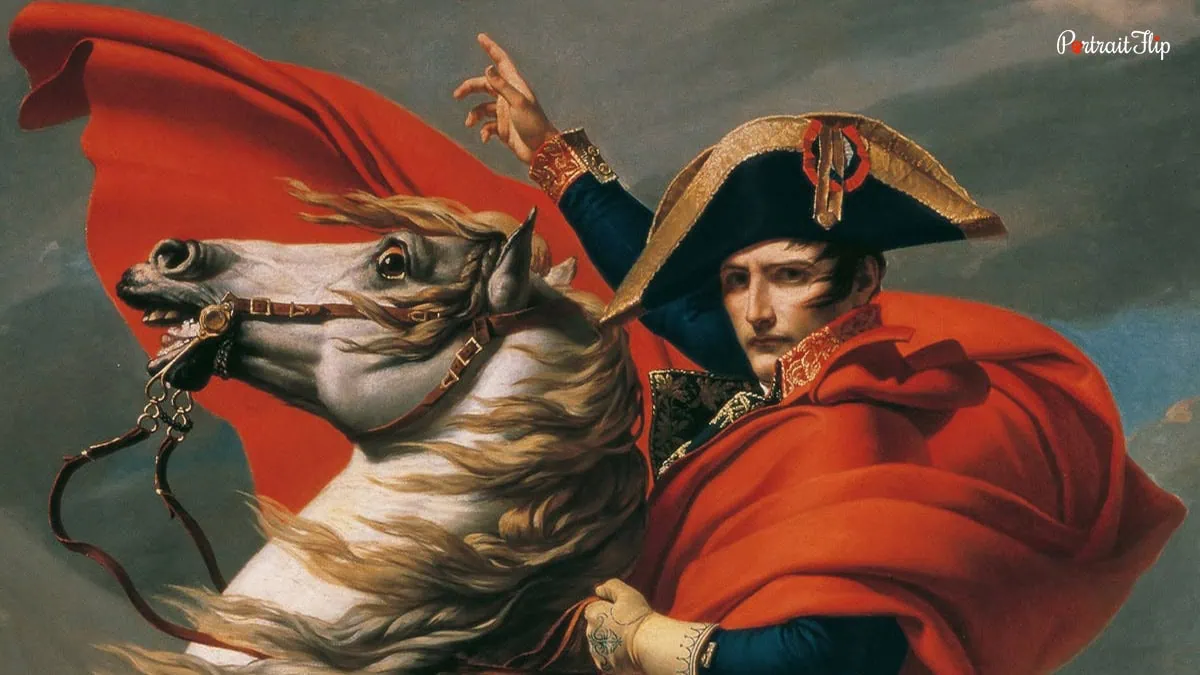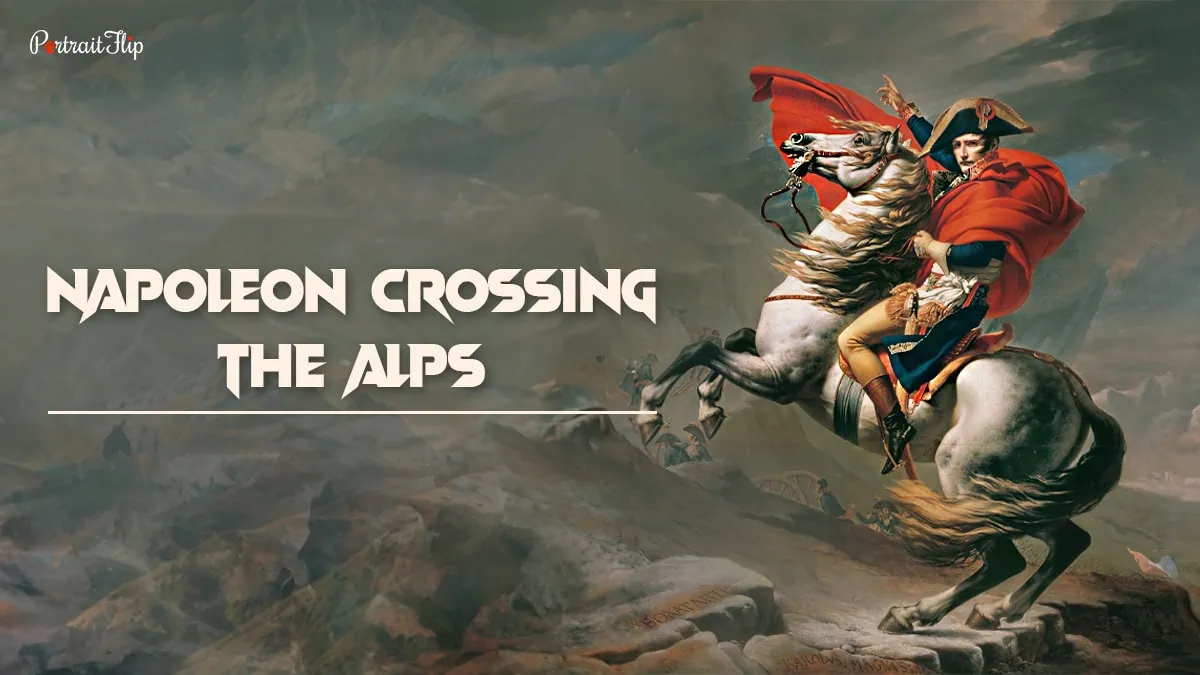A painting that took space among the famous artworks in the world—Napoleon Crossing the Alps by Jacques-Louis David!
The glamor, the valor, and the drama this painting holds, it definitely has a lot to say to the viewer.
There is a lot of history mapped across this painting, so are you willing to indulge in the story of Napoleon crossing the Alps?
I am going to take you through the historical context of the painting and do a short formal analysis of David’s artwork.
Well, how can I not introduce you to the artist himself? We will also briefly look into the artist’s life and how he found his muse in Napoleon.
So, are you ready to dissect this painting with me? You better be!
Who Was Napoleon?

Before we analyze the painting in question, I think we need to get to know a little about the main character here, the great Napoleon himself!
Napoleon I, also known as Napoleon Bonaparte, was a formidable French military leader and emperor in the late 18th and early 19th centuries.
Rising to power during the French Revolution, he became emperor in 1804 and swiftly expanded the French Empire across Europe through his military prowess, notably winning the Battle of Austerlitz.
Napoleon introduced significant reforms in France, including the influential Napoleonic Code, which modernized legal systems globally.
Despite his achievements, his ambition led to costly wars and his ultimate defeat at Waterloo in 1815.
Nevertheless, his legacy endures through his legal reforms and lasting impact on European politics and warfare, marking him as one of history’s most influential figures.
Recommended read: Art Appraisal: Evaluate Estimate of your Artwork
Historical Context of Napoleon Crossing the Alps

Napoleon Crossing the Alps is a famous painting that captures a significant moment in history during the early 19th century.
Created by French artist Jacques-Louis David in 1801, it depicts Napoleon Bonaparte on a majestic horse, leading his army through the Alps mountains.
During this time, Napoleon was a rising military leader in France, known for his ambition and strategic brilliance.
The painting symbolizes Napoleon’s daring and determination, as he planned to invade Italy in 1800 to expand French influence.
The crossing of the Alps was not just a physical challenge but also a symbolic one, showcasing Napoleon’s leadership and his vision of a powerful French empire.
The artwork itself reflects the artistic style of neoclassicism, which was popular during Napoleon’s reign.
It portrays him heroically, emphasizing his strength and resolve amidst the rugged terrain.
The dramatic lighting and composition evoke a sense of grandeur and triumph, emphasizing Napoleon’s larger-than-life persona.
Beyond its artistic merit, Napoleon Crossing the Alps holds historical significance as it immortalizes a pivotal moment in Napoleon’s career and European history.
It signifies the beginning of his military campaigns that would reshape the political landscape of Europe for years to come, marking him as one of history’s most influential figures.
In essence, David’s painting not only captures the spirit of Napoleon’s ambition and leadership but also serves as a testament to the era’s artistic and historical context, making it a timeless depiction of power and conquest.
Recommended Read: Art Investment: A Guide To Investing In Art
Formal Analysis of Napoleon Crossing the Alps
Napoleon Crossing the Alps, painted by Jacques-Louis David in 1801, is a striking piece of art.
It shows Napoleon Bonaparte riding a horse up a snowy, steep mountain.
He looks really confident and determined, wearing a red cloak that flutters in the wind.
The snowy landscape and rugged terrain make it clear that this journey was tough, but Napoleon’s calm and proud stance shows he’s not fazed.
David’s painting isn’t just about recording history; it’s about making Napoleon look like a powerful and heroic leader.
The dramatic colors and strong lines make the scene feel intense and alive. Napoleon’s larger-than-life presence stands out against the wild backdrop, reinforcing his image as a fearless leader.
The painting also uses bold, swirling brushstrokes to capture the movement of the snow and the energy of the scene.
It’s not just about the moment of crossing the Alps but about conveying Napoleon’s unstoppable drive and ambition.
This makes the painting both a historical record and a piece of powerful propaganda, celebrating Napoleon’s legendary status.
Suggested Read: Self-Portrait with Thorn-Necklace and Hummingbird
Conclusion: About the Artist

Jacques-Louis David, a celebrated French artist of the 18th and 19th centuries, painted some of history’s most iconic images, with “Napoleon Crossing the Alps” among his masterpieces.
David was known for his neoclassical style, which emphasized heroic figures and moral themes.
Napoleon Bonaparte, rising as France’s military leader during the tumultuous times of the French Revolution, became David’s muse.
David’s painting of Napoleon Crossing the Alps in 1801 captured the essence of Napoleon’s ambitious spirit and strategic brilliance.
The artwork depicts Napoleon on a fiery steed, leading his army through the treacherous Alpine terrain.
This portrayal wasn’t just about documenting a military maneuver; it symbolized Napoleon’s rise to power and his vision for a dominant French empire.
The painting’s dramatic lighting, dynamic composition, and larger-than-life portrayal of Napoleon underscore David’s skill in creating monumental historical narratives.
Through this piece, David immortalized Napoleon as a heroic figure, reflecting the artist’s own admiration for Napoleon’s leadership and determination.
“Napoleon Crossing the Alps” not only cemented David’s reputation as a painter of historical significance but also highlighted his role in shaping the visual legacy of Napoleon Bonaparte.
It remains a vivid depiction of both artist and subject, capturing a pivotal moment in European history with timeless artistic flair.
Do you also wish to have this magnificent piece of painting on your walls? Because you can always opt to have a reproduction painting made from PortraitFlip.
If not, to take the fun up a notch, you can even flip your face to Napoleon’s and make it a custom royal painting for yourself, what say?
Whatever your wishes are, you know what the destination for it is, so hurry up and make your choice.
And I will see you soon with the next one.
Toodles xx
Frequently Asked Questions
Jacques-Louis David was inspired to paint Napoleon Crossing the Alps to celebrate Napoleon Bonaparte’s military prowess and leadership. The painting was commissioned to commemorate Napoleon’s successful crossing of the Alps during his Italian campaign in 1800. David’s work was intended to enhance Napoleon’s image as a heroic and almost mythical figure, reinforcing his reputation as a determined and invincible leader.
In the painting, Napoleon’s calm and confident demeanor is a deliberate choice by David to emphasize his strength and leadership. Despite the harsh conditions of the Alpine crossing, Napoleon is portrayed as unshaken and resolute. This portrayal is part of David’s aim to present Napoleon as a larger-than-life hero who can conquer any challenge, reinforcing his power and influence.
Napoleon Crossing the Alps painting is more symbolic than historically accurate. While it depicts a dramatic and heroic crossing, historical accounts suggest that Napoleon did not actually cross the Alps on horseback but traveled in a carriage for most of the journey. David’s painting exaggerates and idealizes the event to promote Napoleon’s image as a courageous and legendary leader, rather than a literal historical account.





